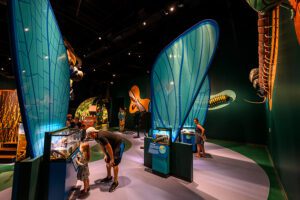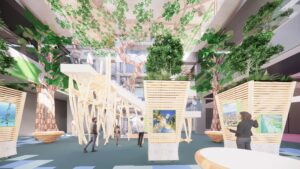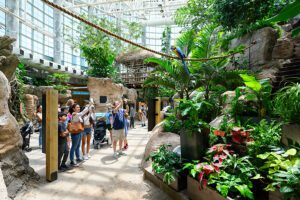Conservation Connection: Local Lessons, Global Importance
By Adam Mitchell and Chris Muskopf
Conservation through Education
The goal of conservation is to preserve and protect something valuable for future generations and many museums, zoos, aquariums and nature centers have grown in their aims to educate and equip their guests to be active participants in caring for the world around them. Unfortunately making these important connections between conservation and education is often challenged by the many diversions presented of life, by 24/7 media and by a lack of direct contact with places and species in everyday life. While environmental and habitat change is often abstract and tangential to our lives, our current cultural and climate moment creates an opportunity for science and nature institutions to leverage interpretive exhibits and enhance visitor understanding of the changing environment and the needed conservation of habitats and wildlife.
The advent of non-stop media coverage of extreme weather in many parts of our country can connect local weather events to global climate change and clarify the connections between weather and conservation: if your basement floods, you seek explanations for torrential rainfall. The heightened coverage of extreme weather can produce a “hope gap” or “climate anxiety” around stewardship and engagement, so institutional communication and conservation programs are invaluable in connecting citizens with tangible and actionable measures within their grasp.
At CambridgeSeven, our approach starts with building bridges between people, places, and animals. Our goal is to leverage local conservation experiences to form wider empathy with ecologies farther afield. This empathy starts with conservation education about your neighborhood: when one understands the importance of municipal stormwater drainage systems, a journey begins that may enable wider understanding. The goal is to connect local conditions to global events.
Restoring the Amazonian Rainforest Could Help Keep Your Basement Dry
A guiding principle is to help visitors understand the connection between their local biosphere, weather events, and the effect on wildlife: Extreme weather such as 500-year floods that now occur annually in New England or the perceived increasingly frequent hurricanes in Florida, or devastating California fires can be contextualized in larger stories about environmental change across our planet. By building connections and telling compelling stories, we can help conserve habitats and animals everywhere.

With its conservation-forward approach, Seneca Park Zoo in Rochester, NY, has shown a record of success in reintroducing native sturgeon species to the Genesee River Building on this idea of bringing positive change beyond the enclosure of the zoo, the CambridgeSeven-designed Tropics Building will connect fragile tropical ecosystems, animals and their habitats with the similar valley ecosystems of the Zoo’s locale, inspiring care and conservation close to home.
Interpretive exhibits and storytelling will connect local visitors to animals of Madagascar, Borneo, and the Pacific Reef habitats, as well as building empathy with these threatened ecosystems and the need to conserve them. The connection is extended from faraway valleys to the local Genesee valley in Rochester, where its lush banks, waters and falls are as rich with habitat as the famous valleys of Ankarana and Kinabatangan in Madagascar and Borneo. Our exhibits highlight the essential conservation work that Seneca Park Zoo is undertaking in Borneo around ecosystem protection, showing that distance is no barrier to the care of place and species.

In New Orleans, we have helped the Audubon Nature Institute (ANI) revamp their exhibits and invigorate their stories about conservation leadership. ANI has an important legacy of connecting the Louisiana Bayou with not only the U.S. Gulf Coast, but the broader community of the Caribbean and Messo-American biosphere. The new Insectarium and Butterfly Garden narrate a fascinating story about the essential role insects play in feeding the world, whether in their role maintaining healthy soil, ensuring an insect biomass in the first chain of the food supply, or as pollinators enabling food production. The health of insects in your neighborhood is indicative of the health of insects in other parts of the world. ANI’s insect collection and interpretive exhibits educate visitors about why insects matter in New Orleans and by extension, the wider world.
In another exhibit, ANI tells a conservation story about the people who live in the Bayou, despite the ravages of the intensifying climate, and how local cultures have adapted to climate change. Their efforts to conserve the Mississippi River Delta are compelling and instructive, and . One such example of this work are the efforts to restore costal salt marsh on the Gulf Coast.
Connecting Character and Climate

Other definitions of conservation rely on the concept of resilience, that is, the ability to withstand or recover from difficulty, The Museum Discovery and Science, located on Florida’s fragile coast, saw an increasing need to focus on the personal character aspect of conservation. The new Build a Better World Together exhibit is committed not only to teaching about engineered environmental protection solutions but also providing young people with tools to understand the environmental stresses of their region and to help address an increasing climate anxiety expressed by this visitor group. The new experience integrates science and climate concepts with positive character traits such as durability, optimism, self-efficacy, systems-thinking and problem-solving skills, all of which have been shown to help children better cope with environmental challenges and maintain hope.
The interactive experience touches new and existing exhibits in the museum, using a range of hands-on interactives and physical challenges to bolster positive character traits such as motivation, determination and perseverance. The overall exhibit is organized around the 4Cs of character: Caring, Cooperation, Confidence and Critical Thinking, with the aim of inspiring future leaders, innovators, and compassionate citizens who will, indeed, build a better world together.
In one thematic thread for example, Caring, the exhibits offer visitors an understanding of the impact of pollution on aquifers and provide them with opportunities to pledge community service. Connecting with wildlife allows children to develop empathy by observing and understanding the needs and behaviors of animals, fostering a sense of responsibility and compassion for living creatures. This virtue forms the foundation for ethical decision-making and responsible citizenship.
Making Technology & Research Accessible to Communities

Sometimes conservation lies at the confluence of cultural and technical resilience. The Resilient Woods Hole project is an initiative by the major scientific research institutions in the Cape Cod village of Woods Hole, Massachusetts. The Woods Hole Oceanographic Institution, Marine Biological Laboratory, National Oceanic and Atmospheric Administration and the Town of Falmouth collaborated to ensure that the vibrant and productive village of Woods Hole prospers well into the future with the advent of major climate impacts such as sea-level rise, coastal flooding, shoreline loss, and associated challenges.
While scientific data and maps and projections can outline challenges and solutions, the leaders of the initiative realized that the human dimension of habitation, the stories of living and working in a place are key to preserving it. CambridgeSeven worked with the initiative and the Village to design an interpretive walking trail that literally provides common ground and a shared viewpoint for community discussions about possible approaches to protect the Village and its relationship with the sea. Each stop highlights a brief history of Woods Hole, climate change projections, adaptation solution charts, current and historic images, and video interviews of leaders and community members to establish a shared appreciation of the village and its unique circumstances.
This article was originally published February 20, 2025
